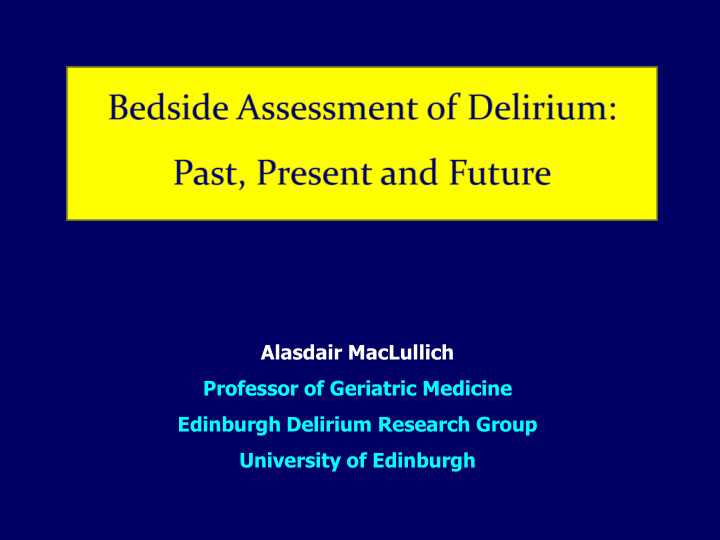



Alasdair MacLullich Professor of Geriatric Medicine Edinburgh Delirium Research Group University of Edinburgh
PAST
attention delusions level of arousal coherent thinking mood Altered mental status language in acute illness memory executive functioning hallucinations visuospatial ability sleep-wake motor activity
attention delusions level of arousal coherent thinking What does bedside mood language assessment consider? memory ONSET FLUCTUATION executive functioning hallucinations visuospatial ability sleep-wake motor activity
History of delirium assessment 1 Before 1980s, general clinical examination Psychiatry-based methods Skilled process 20-30 mins recommended for assessment in one textbook Multiple domains assessed Cognitive testing used to support
History of delirium assessment 2 DSM- III in 1980 (used term ‘delirium’) Specific assessment tools emerged from 1980s onwards Initially mostly suitable for research (complex, lengthy) Shorter scales, eg. Confusion Assessment Method, from 90s
History of delirium assessment 3 By 2017, >30 tools Different purposes: Rapid clinical screening Severity Surveillance Etc.
Grover & Kate, 2012
Cognitive testing Several studies of cognition in delirium Attention: many tools assessed, eg. digit span Used to support overall Dx; no numerical thresholds
Impact on clinical practice Increasing awareness Appearance of tools like CAM, DOSS in clinical protocols Some evidence of clinical use & impact Rates of delirium detection very low (<20%)
Focus on diagnostic criteria Acute onset Fluctuating course Inattention Other cognitive deficits …. less coverage of mood, psychosis
PRESENT
Present status of delirium assessment Chaotic picture Recent UK survey (N=2300): 60% have guidelines But followed in a minority Still <20% of delirium detected
Signs of encouragement? National/international guidelines (eg. NICE in UK) Increasingly a target for implementation Tools with more focus on clinical use Delirium superimposed on dementia work Level of arousal / untestability issue addressed
Trzepacz et al Psych Res 1988
Normal function Range of delirium severity Range of abnormalities of cognition: quantifiable Range of level of arousal ‘Untestable’ with most cognitive tests Coma
Validation of the 4AT, a new instrument for rapid delirium screening: a study in 234 hospitalised older people Bellelli et al., Age Ageing, 2014 N=234 consecutive older patients Acute geriatrics and rehabilitation settings 4AT compared against reference standard
Sensitivity and Specificity Score Sensitivity Specificity Full Score 4 or above 89.7% 84.1% Alertness 4 53.2% 96.1% AMT4 1 96.6% 54.6% 2 89.7% 80.2% Attention 1 93.1% 49.8% 2 86.2% 82.6% Acute 4 69.0 % 94.2% change/Fluctuation
FUTURE
Aiming high… All delirium detected and monitored until resolution Specific features in individual patients assessed and treated
Learning from the past “The existence and the diagnostic criteria, as well as the clinical importance of delirium, have not been sufficiently emphasised in the teaching of medical students and residents.” Lipowski, 1990
Learning from the past Good assessment methods ≠ implementation Even good education ≠ implementation
Infrastructure Infrastructure Effective bedside assessment of delirium Infrastructure Infrastructure
Basic knowledge in Culture practitioners Effective bedside assessment of Attitudes Skills delirium Rx after Dx Quality control Institutional knowledge + support
Future: a system of assessments DIAGNOSIS SCREENING (Unclear) Rapid, pragmatic May be same process as screening Routine staff can use INDIVIDUAL FEATURES SURVEILLANCE Symptom domains For incident delirium Mood, psychosis, etc. MONITORING FOR RECOVERY Tracking symptoms Serial cognitive testing
Screening For use in routine care by mostly non-specialist staff Fast, simple, easy to train Focused on diagnostic features (onset, inattention) NB informant history not always necessary (dangerous to wait) In some cases screening leads directly to diagnosis
Diagnosis Staff with sufficient training Screening tool then clinical judgement Additional tool not usually possible in routine care
“Delirium is usually accompanied by profound affective changes.” Koponen, Rockwood, & Powell, 2001
Distress: why is it not formally assessed?
Not just diagnosis: assess features of delirium What is this patient’s delirium like? (Restoring some of the traditional approaches)
attention delusions level of arousal coherent thinking mood Altered mental status language in acute illness memory executive functioning hallucinations visuospatial ability sleep-wake motor activity
Not just diagnosis: assess features of delirium What is this patient’s delirium like? (Restoring some of the traditional approaches) Cognition Level of arousal Anxiety Low mood Fear, uncertainty Delusions Hallucinations Etc.
Features of a patient’s delirium Individualised treatment plan
Specific features and delirium Rx: examples Distress Missing a relative, delusions, disorientation, pain, retention Leads to specific actions including psychological interventions Reduced arousal Swallowing assessment (aspiration risk), pressure sores, dehydration, malnourishment, no rehabilitation, etc. Increased arousal Falls, risk of leaving ward, may not accept drugs/fluids, risk of over-sedation if no clear plan, no rehabilitation, etc.
Surveillance of non-delirious high risk patients ~50% of delirium arises after hospital admission Nursing home, palliative care populations Staff training to be aware of CHANGE Tools Delirium Observation Screening Scale RADAR Arousal assessments
Monitoring for recovery Based on individual features of a patient’s delirium Monitoring of resolution of these features Repeated level of arousal assessments (eg. RASS) Repeated cognitive assessments (eg. DelApp) Motor control assessments (eg. Trunk Control Test) ?EEG in some patients
Conclusions and future work
Conclusions Since 1980s, many developments in delirium assessment Now, several useful, validated tools for different purposes Assessment is chaotic and patchy But delirium still poorly detected Improvements wil depend on: *Culture, attitudes, education (practitioners + organisations)* Organised, explicit systems of assessment Processes for: screening, Dx, features, surveillance, monitoring for recovery
Recommend
More recommend